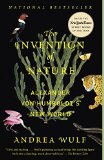Summary | Excerpt | Reviews | Beyond the Book | Readalikes | Genres & Themes | Author Bio

Alexander von Humboldt's New World
by Andrea WulfExcerpt
The Invention of Nature
Five months after his arrival, Humboldt finally left Quito on 9 June 1802. He still intended to travel to Lima, even though Captain Baudin wouldn't be there. From Lima Humboldt hoped to find passage to Mexico, which he also wanted to explore. First, though, he was going to climb Chimborazo – the crown of his obsession. This majestic inactive volcano – a 'monstrous colossus' as Humboldt described it – was about one hundred miles to the south-west of Quito and rose to almost 21,000 feet.[7]7
As Humboldt, Bonpland, Montúfar and José rode towards the volcano, they passed thick tropical vegetation. In the valleys they admired daturas with their large trumpet-shaped orange blossoms and bright red fuchsias with their almost unreal-looking sculptural petals. Then, as the men slowly ascended, these voluptuous blooms were replaced by open grass plains where herds of small llama-like vicuñas grazed. Then Chimborazo appeared on the horizon, standing alone on a high plateau, like a majestic dome. For several days as they approached, the mountain stood out against the vibrant blue of the sky with no cloud smudging its imposing outline. Whenever they stopped, an excited Humboldt took out his telescope. He saw a blanket of snow on the slopes and the landscape around Chimborazo appeared barren and desolate. Thousands of boulders and rocks covered the ground, as far as he could see. It was an otherworldly scenery. By now Humboldt had climbed so many volcanoes that he was the most experienced mountaineer in the world but Chimborazo was a daunting prospect even to him. But what appeared unreachable, Humboldt later explained, 'exerts a mysterious pull'.
On 22 June they arrived at the foot of the volcano where they spent a fitful night in a small village. Early the next morning, Humboldt's team began the ascent together with a group of local porters. They crossed the grassy plains and slopes on mules until they reached an altitude of 13,500 feet. As the rocks became steeper, they left the animals behind and continued on foot. The weather was turning against them. It had snowed during the night and the air was cold. Unlike the previous days, the summit of Chimborazo was shrouded in fog. Once in a while the fog lifted, granting them a brief yet tantalizing glimpse of the peak. It would be a long day.
At 15,600 feet their porters refused to go on. Humboldt, Bonpland, Montúfar and José divided the instruments between them and continued on their own. The fog held Chimborazo's summit in its embrace. Soon they were crawling on all fours along a high ridge that narrowed to a dangerous two inches with steep cliffs falling away to their left and right – fittingly the Spanish called this ridge the cuchilla, or 'knife edge'. Humboldt looked determinedly ahead. It didn't help that the cold had numbed their hands and feet, nor that the foot that he had injured during a previous climb had become infected. Every step was leaden at this height. Nauseous and dizzy with altitude sickness, their eyes bloodshot and their gums bleeding, they suffered from a constant vertigo which, Humboldt later admitted, 'was very dangerous, given the situation we were in'. On Pichincha Humboldt's altitude sickness had been so severe that he had fainted. Here on the cuchilla, it could be fatal.
Despite these difficulties, Humboldt still had the energy to set up his instruments every few hundred feet as they ascended. The icy wind had chilled the brass instruments and handling the delicate screws and levers with half-frozen hands was almost impossible. He plunged his thermometer into the ground, read the barometer and collected air samples to analyse its chemical components. He measured humidity and tested the boiling point of water at different altitudes. They also kicked boulders down the precipitous slopes to test how far they would roll.
Excerpted from The Invention of Nature by Andrea Wulf. Copyright © 2015 by Andrea Wulf. Excerpted by permission of Knopf, a division of Random House LLC. All rights reserved. No part of this excerpt may be reproduced or reprinted without permission in writing from the publisher.






Your guide toexceptional books
BookBrowse seeks out and recommends the best in contemporary fiction and nonfiction—books that not only engage and entertain but also deepen our understanding of ourselves and the world around us.